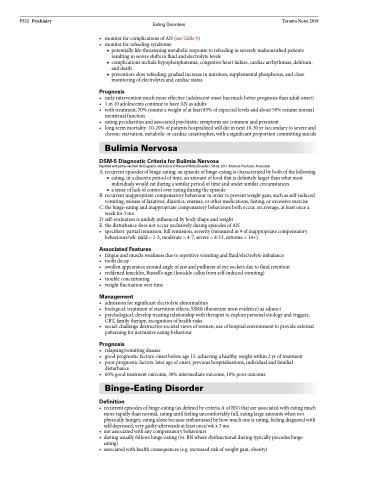Page 1196 - TNFlipTest
P. 1196
PS32 Psychiatry Eating Disorders Toronto Notes 2019
• monitor for complications of AN (see Table 9) • monitor for refeeding syndrome
■ potentially life-threatening metabolic response to refeeding in severely malnourished patients resulting in severe shifts in fluid and electrolyte levels
■ complications include hypophosphatemia, congestive heart failure, cardiac arrhythmias, delirium, and death
■ prevention: slow refeeding, gradual increase in nutrition, supplemental phosphorus, and close monitoring of electrolytes and cardiac status
Prognosis
• early intervention much more effective (adolescent onset has much better prognosis than adult onset) • 1 in 10 adolescents continue to have AN as adults
• with treatment, 70% resume a weight of at least 85% of expected levels and about 50% resume normal
menstrual function
• eating peculiarities and associated psychiatric symptoms are common and persistent
• long-term mortality: 10-20% of patients hospitalized will die in next 10-30 yr (secondary to severe and
chronic starvation, metabolic or cardiac catastrophes, with a significant proportion committing suicide
Bulimia Nervosa
DSM-5 Diagnostic Criteria for Bulimia Nervosa
Reprinted with permission from the Diagnostic and Statistical Manual of Mental Disorders, 5th ed. 2013. American Psychiatric Association
A. recurrent episodes of binge-eating; an episode of binge-eating is characterized by both of the following ■ eating, in a discrete period of time, an amount of food that is definitely larger than what most
individuals would eat during a similar period of time and under similar circumstances ■ a sense of lack of control over eating during the episode
B. recurrent inappropriate compensatory behaviour in order to prevent weight gain, such as self-induced vomiting, misuse of laxatives, diuretics, enemas, or other medications, fasting, or excessive exercise
C. the binge-eating and inappropriate compensatory behaviours both occur, on average, at least once a week for 3 mo
D. self-evaluation is unduly influenced by body shape and weight
E. the disturbance does not occur exclusively during episodes of AN
• specifiers: partial remission, full remission, severity (measured in # of inappropriate compensatory
behaviours/wk: mild = 1-3, moderate = 4-7, severe = 8-13, extreme = 14+)
Associated Features
• fatigue and muscle weakness due to repetitive vomiting and fluid/electrolyte imbalance
• tooth decay
• swollen appearance around angle of jaw and puffiness of eye sockets due to fluid retention • reddened knuckles, Russell’s sign (knuckle callus from self-induced vomiting)
• trouble concentrating
• weight fluctuation over time
Management
• admission for significant electrolyte abnormalities
• biological: treatment of starvation effects, SSRIs (fluoxetine most evidence) as adjunct
• psychological: develop trusting relationship with therapist to explore personal etiology and triggers,
CBT, family therapy, recognition of health risks
• social: challenge destructive societal views of women, use of hospital environment to provide external
patterning for normative eating behaviour
Prognosis
• relapsing/remitting disease
• good prognostic factors: onset before age 15, achieving a healthy weight within 2 yr of treatment • poor prognostic factors: later age of onset, previous hospitalizations, individual and familial
disturbance
• 60% good treatment outcome, 30% intermediate outcome, 10% poor outcome
Binge-Eating Disorder
Definition
• recurrentepisodesofbinge-eating(asdefinedbycriteriaAofBN)thatareassociatedwitheatingmuch more rapidly than normal, eating until feeling uncomfortably full, eating large amounts when not physically hungry, eating alone because embarrassed by how much one is eating, feeling disgusted with self/depressed, very guilty afterwards at least once/wk x 3 mo
• notassociatedwithanycompensatorybehaviours
• dietingusuallyfollowsbinge-eating(vs.BNwheredysfunctionaldietingtypicallyprecedesbinge-
eating)
• associatedwithhealthconsequences(e.g.increasedriskofweightgain,obesity)


